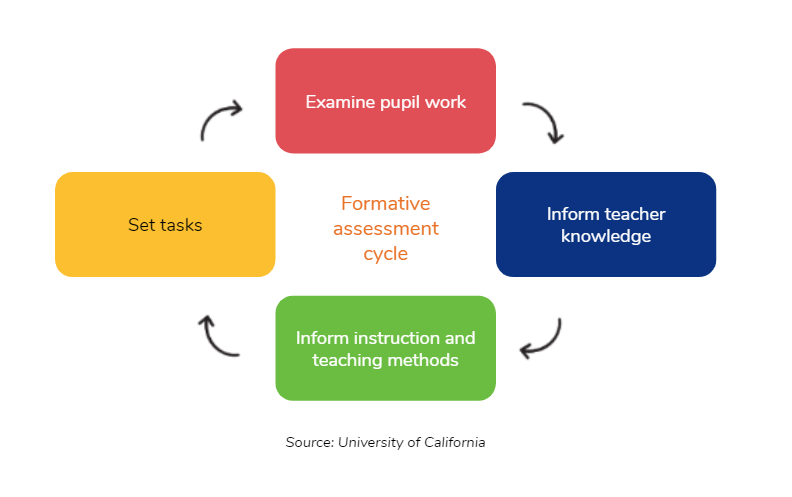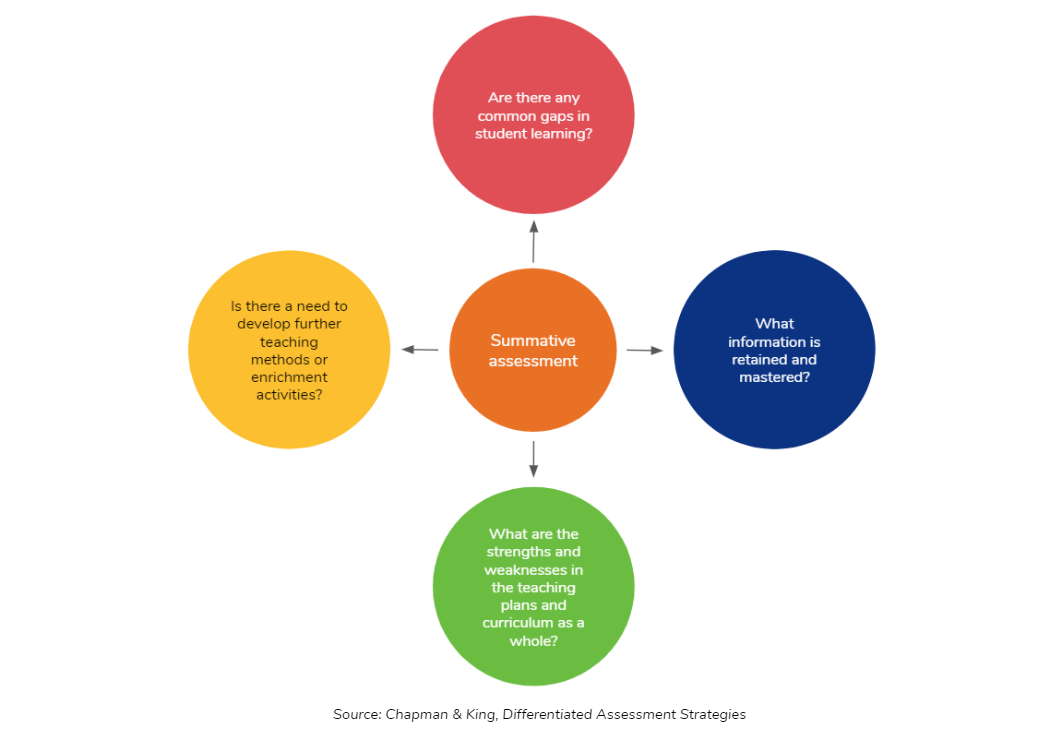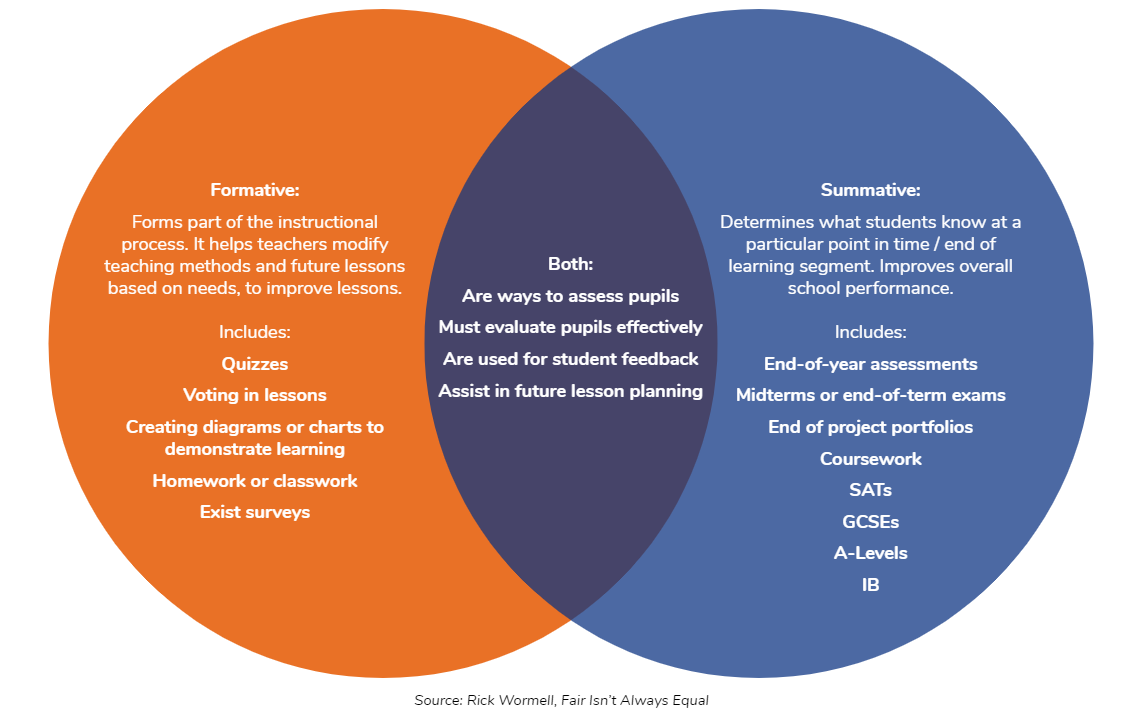Assessment Overview
| Site: | Hampshire Participation and Lifelong Learning |
| Course: | Tutor Handbook |
| Book: | Assessment Overview |
| Printed by: | Guest user |
| Date: | Thursday, 11 December 2025, 4:32 PM |
Description
Tutors and learners are continuously engaged in the process of assessment, even though it may not be overt, planned or formal.
This overview will consider the types of assessment
- Initial Assessment
- Formative Assessment (Assessment for Learning)
- Summative Assessment (Assessment of Learning
Purpose of assessment
Many learners may feel intimidated by the word “assessment”. Research has identified that some learners
associate the term with judgemental, unsympathetic attitudes, possibly because
of negative experiences. However, learners
do value feedback; they do want their work to be assessed; and want to know how
to improve.
The tutor’s skill lies in devising means of assessment, which do not intimidate and in preparing learners effectively for more formal means of assessment. Finding out how learners feel about assessment is an important element of this and can form part of the initial assessment, which takes place during induction.
Assessment is an important part of the learning cycle and enables tutors to:
- Check and note learners’ responses
- Observe learner progress
- Adjust what they are doing to meet learners’ needs
- Have in their minds the standards that are expected for the group and for individuals
- Have
expectations of the group and of individuals
Assessment is also beneficial to learners:
- Have expectations of success or failure which change as the programme progresses
- Compare themselves with others both within and outside the group
- Have ideas about what they would like to achieve
- Make judgements about how far they are making progress
Assessment may be initial, formative or summative.
Initial Assessment
Initial Assessment
Initial Assessment is the first part of the RARPA process. It provides the platform for course development, and ensures the curriculum is appropriate to the learners needs.
Initial Assessment:
- Establishes the existing skill and knowledge levels of learners
- May establish how each learner learns
- Introduces learners to some of the skills and knowledge they will need to acquire on the programme
- Provides information to help tutors plan the programme
- Can be a fun way of getting learners used to assessment without it being too intimidating
Well-planned and executed initial assessment is integral to the
induction process. This may commence at
the enrolment stage with a pre-course questionnaire to establish learners’
interests, experience and motivation. It
may be part of the “getting to know you” activity in induction.
It is important, however, that there is also
- some form of skill/knowledge assessment which can be validated by the tutor
- discussion with individual learners about what they can do and want to be able to do
See ‘first session’ section of this handbook for more information.
Assessment for Learning - Formative Assessment
Assessment for learning (AfL) also known as Formative assessment, is a method of assessing learners while learning is happening rather than at the end of a topic or sequence of lessons (summative assessment).
AfL can be conducted through a variety of methods, such as targeted questioning, exit questions and recap starter activities, or peer and self-assessment that promotes reflection and the sharing of knowledge.
It is integrated and ongoing, moving away from marks, grades and levels. A key principle of this style of assessment is that, in evaluating the comprehension levels and learning needs of learners, tutors can amend and tailor their approach in future. It ensures that tutors are responsive to learner’s individual progress. It helps ensure learning objectives are met as the tutor can identify any difficulties learners might be having and adapt the content and strategies to support learning, enabling learners to achieve success in their course. It also helps to stretch and challenge learners as you are able to identify the more able learners and set them additional tasks beyond the core curriculum.
Assessment for learning can be conducted through a variety of activities, including;
- in-class or online quizzes
- problem solving activities
- activity/worksheets
- demonstrating
- activities to recap previous week’s learning
- homework activities
In summary AfL takes place throughout the course and involves checking that learning is taking place including:
- finding out what knowledge and skills the learners have acquired
- helping to plan the next steps
- enabling the tutor to give feedback
- encouraging motivation
- helping the tutor to modify the course if necessary
- enabling learners to identify what they have learned and what they want to learn next

https://www.tes.com/news/pedagogy-focus-formative-assessment
https://mikegershon.com/assessment-for-learning-simplified/
Summative Assessment
Summative assessment is used to assess learner’s achievement at
the end of a course or topic. It should
relate directly to the learning aims and objectives. It provides a summary picture of what the
learner has learnt during the course.
Some aspects of summative assessment use formal methods of assessment
(tests/exams) but this is not always the case, especially with adult community learning.
Summative assessment can be used to:
- enable learners to recognise their achievements
- justify awarding a qualification
- help the tutor plan future courses
- guide learners through their next steps
There are a variety of methods for conducting summative
assessment, and not all of these are formal written assessments
- Digital assets (video, audio, website)
- Portfolios
- Observation of practical task
- End product e.g. something the learner has made using new skills
- Discussion with learner
- Written unseen exams
- Multiple choice question (MCQ) exams
- Open book exams
- Seen exams
- Essay submissions
- Dissertations

Methods of assessment
Here are some ideas of activities that can be used as assessment activities/evidence:
|
Think about different methods when assessing your learners.
Some methods can be used for both formative and summative assessment

https://resourced.prometheanworld.com/types-of-summative-formative-assessment/
https://www.teachthought.com/pedagogy/20-simple-assessment-strategies-can-use-every-day/
Feedback on assessment
Learners appreciate feedback, which should always be given after
assessment. It is a vital part of the learning process and may be given
verbally or in writing. Feedback is an essential part of
effective learning. It helps students understand the subject being studied
and gives them clear guidance on how to improve their learning.
Good feedback is a two-way process and the learner should engage in the learning opportunity process.
Skilled tutors use feedback to learners for two things:
- To identify learners current strengths and weaknesses
- To identify what the learner needs to improve
“Professor John Hattie found that
Feedback has more effect on achievement than any other factor. Professors Paul
Black and Dylan Wiliam of Kings College London spent four years studying and
reviewing research into feedback which is closely linked to ‘formative
assessment’. They concluded in agreement with Professor Hattie that formative
assessment has a huge effect on learning quality. It has been found to add the
equivalent of two grades to students’ achievement if done very well.” (http://geoffpetty.com/for-teachers/feedback-and-questions/)
Learners need information on what
they do well, and how to improve, then they need to act on this. Teachers can
give feedback, but learners can too, with self- assessment and peer assessment.
The best feedback (or formative assessment) uses learner’s work to diagnose
strengths and weaknesses, and to set individual targets for improvement
Good feedback will result in
- improved learning
- changing traditional classroom practices
- clarifying learning criteria
- raising achievement
- increased leaner engagement
- increased learner confidence
- moving the learner forward in the development of their skills, knowledge and understanding
Good feedback will enable:
- the learner to clarify understanding,
- allow for misconceptions to be rectified,
- provision of a measure of progress towards learning outcomes,
- identification of areas of that need improvements
“Feedback is only successful if students’ learning improves – and this depends on their capacity to understand it and inclination to accept and act on it. It’s got an interpersonal, motivational element that can’t be brushed aside. Giving feedback isn’t a purely technical, objective task – although it does have to suggest actions students can actually take rather than offering a nebulous retrospective critique” Tom Sherrington January 10, 2019 available at https://teacherhead.com/2019/01/10/revisiting-dylan-wiliams-five-brilliant-formative-assessment-strategies/
Feedback should:
- Be constructive
- Be analytical and precise
- Give emphasis to things done well
- Explain what needs to be done differently
- Be clearly expressed
- Show the way forward
- Check that the learner has understood what needs to be done
- Leave the learner feeling positive about his/her learning
- Address the needs of the group and the individual
- Progress learning
Consider the Feedback Sandwich
- Make it fresh
- Keep the filling straightforward
- Aim for a balance of tastes
|
Something positive |
|
Something which could be different |
|
Something positive |
To explore feedback further:
Read “Inside the black box” at: https://weaeducation.typepad.co.uk/files/blackbox-1.pdf
See also Geoff Petty’s books: ‘How to Teach Even Better: an evidence based approach’. (2018) Oxford University Press – chapter 11
‘Teaching Today: a practical guide’ 5th Ed (2014) Oxford University Press – chapters 6 and 43.